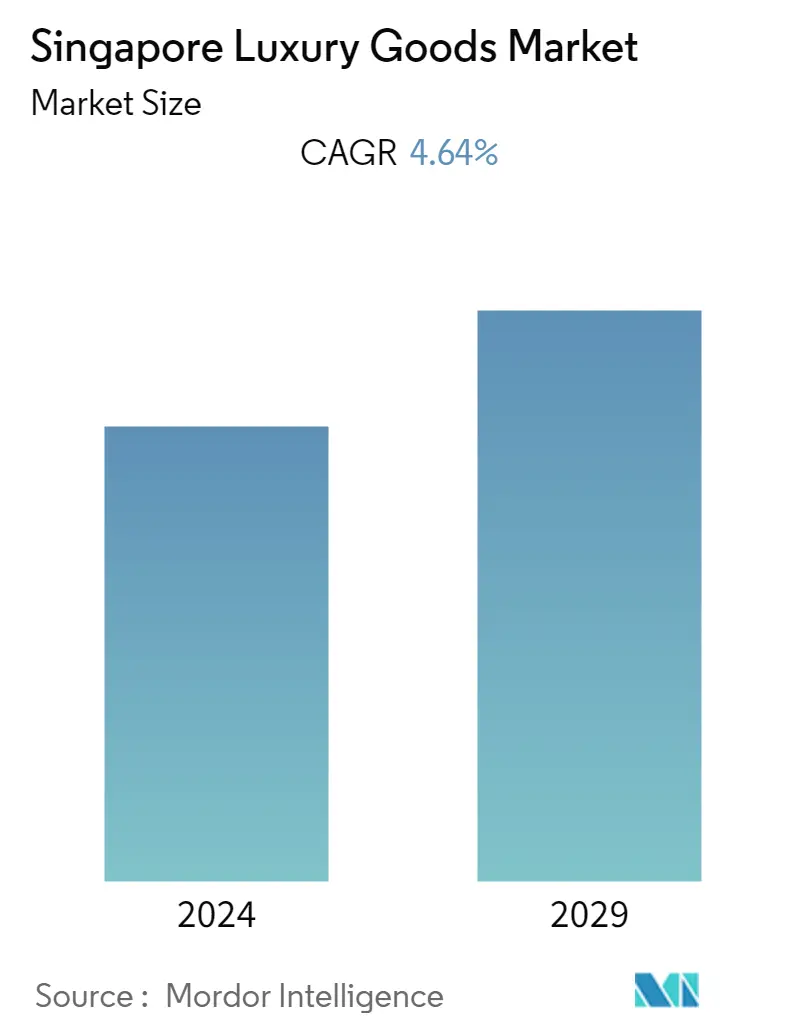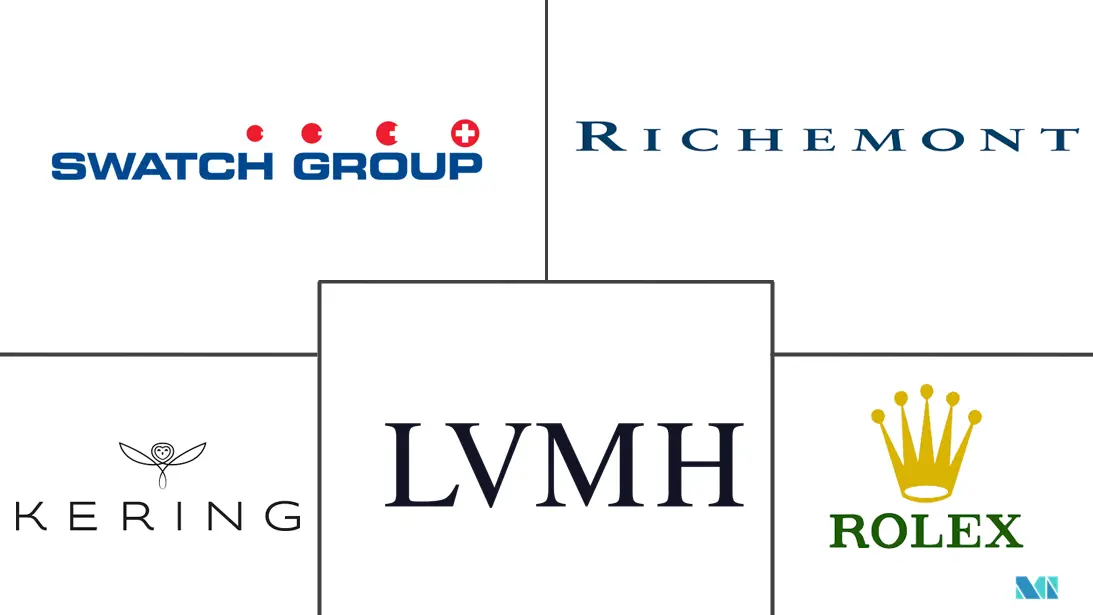Market Size of Singapore Luxury Goods Industry

| Study Period | 2019 - 2029 |
| Base Year For Estimation | 2023 |
| Forecast Data Period | 2024 - 2029 |
| Historical Data Period | 2019 - 2022 |
| CAGR | 4.64 % |
| Market Concentration | Low |
Major Players
*Disclaimer: Major Players sorted in no particular order |
Singapore Luxury Goods Market Analysis
The Singapore luxury goods market is projected to register a CAGR of 4.64% during the forecast period (2022 - 2027).
With the onset of COVID-19, players realized the disadvantages of having only brick and mortar as the sales channel; thereby, they started to strategize and diversify their distribution channels. The majority of the players started developing their digital channels in an effort to reduce the buyer-seller gap.
Over the medium term, the rising growth for hard luxury goods in Singapore is supported by the new entrants of jewelry brands and rising sales of watches. Rapid urbanization coupled with increasing disposable income in the country is predicted to boost the customer base and prominent contributor to the revenue of the hard luxury goods market.
Some of the important factors which have fueled growth in the luxury goods market of Singapore include consumers demanding luxury goods from different backgrounds, rapidly changing consumer trends, the growth of boutique luxury brands, and the massive shift from physical to digital channels, shifting social attitudes towards the display of wealth and others are creating a new competitive landscape for the luxury goods market.
Moreover, apart from the aforementioned attributes, the advantage of being an international free port is another major factor that has encouraged the sales of luxury products in the country over the years. This has resulted in comparatively higher spending by tourists in Singapore relative to its neighbors. Owing to these factors, many premium international brands are looking forward to expand their investments and presence in Singapore. In May 2022, the high-jewellery brand Buccellati opened its first boutique in Singapore at the shops at Marina Bay Sands, that has brought over the best of Italian savoir-faire with its iconic High Jewellery pieces.
The emergence of e-commerce has provided consumers easy access to product-related information and prices through online sources. This has further contributed to the overall growth of the luxury goods market. Consumers in Singapore are highly conscious about their choices of luxury cosmetics and fragrances. Hence, the companies operating in the market are working to enhance their packaging styles that are sustainable.
Singapore Luxury Goods Industry Segmentation
A luxury good is a premium/high-end product available in the market landscape. Singapore luxury goods market is segmented by type into clothing and apparel, footwear, bags, jewelry, watches, and other accessories. By distribution channel, the market is segmented into single-branded stores, multi-brand stores, online retail stores, and other distribution channels.. For each segment, the market sizing and forecasts have been done on the basis of value (in USD million).
| By Type | |
| Clothing and Apparel | |
| Footwear | |
| Bags | |
| Jewellery | |
| Watches | |
| Other types |
| By Distibution Channel | |
| Single-branded Stores | |
| Multi-brand Stores | |
| Online Retail Stores | |
| Other Distribution Channels |
Singapore Luxury Goods Market Size Summary
The Singapore luxury goods market is experiencing a dynamic transformation, driven by a shift from traditional brick-and-mortar sales channels to digital platforms. This transition has been accelerated by the COVID-19 pandemic, prompting luxury brands to enhance their online presence and diversify distribution channels. The market is witnessing a surge in demand for hard luxury goods, such as jewelry and watches, fueled by urbanization and increasing disposable incomes. The emergence of boutique luxury brands and changing consumer trends are reshaping the competitive landscape, while Singapore's status as an international free port continues to attract high-spending tourists, further boosting luxury sales. The market's growth is also supported by the rising influence of culture and social attitudes towards wealth display, which are encouraging higher spending on luxury items.
The rapid expansion of e-commerce is a significant factor contributing to the market's growth, with Singapore boasting one of the highest internet penetration rates globally. Consumers are increasingly engaging with luxury brands through online platforms, driven by the convenience and enhanced shopping experiences these channels offer. Major luxury players, including The Swatch Group, LVMH, Rolex SA, Kering SA, and Richemont SA, are actively pursuing strategic initiatives such as mergers, expansions, and product launches to capture a larger market share. The introduction of limited edition products and collaborations, such as Breitling's partnership with Singapore Airlines, exemplifies the competitive strategies employed by brands to entice consumers. As the market continues to evolve, the integration of digital strategies and the focus on consumer preferences are expected to drive sustained growth in Singapore's luxury goods sector.
Singapore Luxury Goods Market Size - Table of Contents
-
1. MARKET DYNAMICS
-
1.1 Market Drivers
-
1.2 Market Restraints
-
1.3 Porter's Five Force Analysis
-
1.3.1 Threat of New Entrants
-
1.3.2 Bargaining Power of Buyers/Consumers
-
1.3.3 Bargaining Power of Suppliers
-
1.3.4 Threat of Substitute Products
-
1.3.5 Intensity of Competitive Rivalry
-
-
-
2. MARKET SEGMENTATION
-
2.1 By Type
-
2.1.1 Clothing and Apparel
-
2.1.2 Footwear
-
2.1.3 Bags
-
2.1.4 Jewellery
-
2.1.5 Watches
-
2.1.6 Other types
-
-
2.2 By Distibution Channel
-
2.2.1 Single-branded Stores
-
2.2.2 Multi-brand Stores
-
2.2.3 Online Retail Stores
-
2.2.4 Other Distribution Channels
-
-
Singapore Luxury Goods Market Size FAQs
What is the current Singapore Luxury Goods Market size?
The Singapore Luxury Goods Market is projected to register a CAGR of 4.64% during the forecast period (2024-2029)
Who are the key players in Singapore Luxury Goods Market?
The Swatch Group Ltd, Rolex SA, Richemont SA, Kering SA and LVMH Moet Hennessy Louis Vuitton are the major companies operating in the Singapore Luxury Goods Market.

